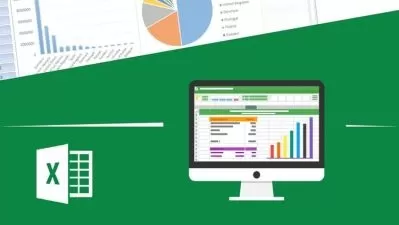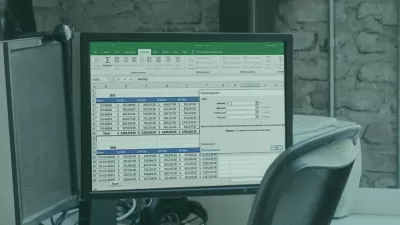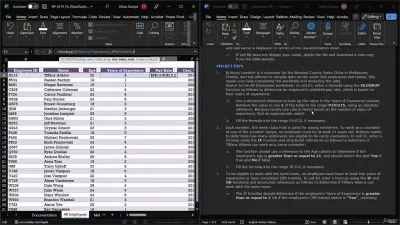Financial Modeling [2023]: Complete finance course on Excel
Yassine Rochd
3:25:21
Description
Financial Modeling practical case and training on Excel - Business Plan, Valuation, and Financial Modeling on Excel
What You'll Learn?
- Gain proficiency in the modeling rules followed by investment bankers, private equity professionals, and transaction services consultants
- Build a clear, comprehensive, and well-organized financial model in Excel
- Acquire a solid foundation in financial modeling fundamentals
- Create a complete business plan in Excel
- Review the essential and fundamental accounting and corporate finance concepts for financial modeling
- Construct a cash flow statement and calculate free cash flows (FCF)
- Model financial debt and simulate principal and interest repayments.
- Determine the company's Enterprise Value using the comparable method and deduct the Equity Value
- Establish a normative EBITDA
- Using Excel, calculate the investment multiple and the internal rate of return (IRR) for a transaction
Who is this for?
What You Need to Know?
More details
DescriptionIf you are interested in finance careers, such as Private Equity, M&A, financial control or financial management, you must have realized that there is a key skill to master in all these finance fields: it's financial modeling.
Whether you are building a business plan, a financial reporting, or performing a company valuation, you will need this skill.
This comprehensive course on financial modeling on Excel will provide you with the knowledge, codes, and best practices to be able to create a clear, well-structured Excel model that meets the expectations of investment banks, Private Equity funds, and financial management teams.
In this training, you will learn about financial modeling standards and the rules to follow to achieve a professional outcome.
You will learn how to design a comprehensive financial model with multiple investment scenarios, a debt schedule with multiple financing tranches and varying characteristics, a clear Sources & Uses table, a professional Business Plan, and a company valuation model based on comparable transactions using a normative EBITDA. Finally, we will calculate the IRR and we will sensitize it according to the investment exit parameters.
Of course, if you are not yet familiar with all these concepts, we will go over what they refer to before starting the financial modeling on Excel.
This course covers essential fundamentals in finance that are necessary to master if you are interested in financial controlling, financial analysis, or transactional careers (PE, M&A, TS).
Who this course is for:
- Finance students who are interested in highly competitive areas of corporate finance such as Private Equity, Venture Capital, M&A, Leveraged Finance, ECM, Transaction Services, Restructuring, Valuation, and, of course, financial modeling
- Candidates for an interview in finance who want to practice and prepare for Excel-based financial modeling cases
- Corporate finance interns seeking to enhance their skills in finance, financial modeling and Excel
- Junior analysts in corporate finance
- Senior finance analysts who aim to enhance their proficiency in financial modeling using Excel
If you are interested in finance careers, such as Private Equity, M&A, financial control or financial management, you must have realized that there is a key skill to master in all these finance fields: it's financial modeling.
Whether you are building a business plan, a financial reporting, or performing a company valuation, you will need this skill.
This comprehensive course on financial modeling on Excel will provide you with the knowledge, codes, and best practices to be able to create a clear, well-structured Excel model that meets the expectations of investment banks, Private Equity funds, and financial management teams.
In this training, you will learn about financial modeling standards and the rules to follow to achieve a professional outcome.
You will learn how to design a comprehensive financial model with multiple investment scenarios, a debt schedule with multiple financing tranches and varying characteristics, a clear Sources & Uses table, a professional Business Plan, and a company valuation model based on comparable transactions using a normative EBITDA. Finally, we will calculate the IRR and we will sensitize it according to the investment exit parameters.
Of course, if you are not yet familiar with all these concepts, we will go over what they refer to before starting the financial modeling on Excel.
This course covers essential fundamentals in finance that are necessary to master if you are interested in financial controlling, financial analysis, or transactional careers (PE, M&A, TS).
Who this course is for:
- Finance students who are interested in highly competitive areas of corporate finance such as Private Equity, Venture Capital, M&A, Leveraged Finance, ECM, Transaction Services, Restructuring, Valuation, and, of course, financial modeling
- Candidates for an interview in finance who want to practice and prepare for Excel-based financial modeling cases
- Corporate finance interns seeking to enhance their skills in finance, financial modeling and Excel
- Junior analysts in corporate finance
- Senior finance analysts who aim to enhance their proficiency in financial modeling using Excel
User Reviews
Rating
Yassine Rochd
Instructor's Courses
Udemy
View courses Udemy- language english
- Training sessions 55
- duration 3:25:21
- Release Date 2023/07/12


























